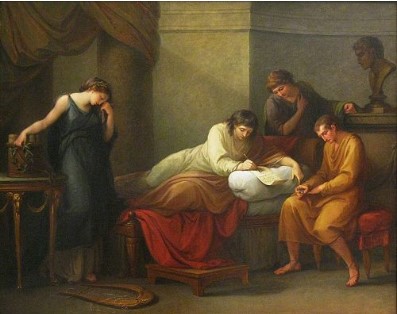Neo classical age;
The neoclassical age, also known as the era of reason, was a period of Western art, literature and architecture covering the 18th century. The term "neoclassical" refers to the renewal of interest in classical forms, topics and ideals that arose at this time.
In the literature, neoclassical writers emphasized the mind, logic and clarity and often wrote in a formal, elegant style, which was supposed to imitate the spelling of ancient Greek and Roman authors. This emphasis on mind and logic also led to the development of satire and use of wit and humor to criticize social norms and values.
In art and architecture, neoclassicism emphasized symmetry, proportion and simplicity, draws inspiration from the art and architecture of ancient Greece and Rome. This can be seen in the design of public buildings, such as government buildings and museums, as well as in decorative art, such as furniture and textiles.
The neoclassical age was also marked by a growing interest in science and the world of nature, as well as by faith, due to the human mind, to solve problems and improve society. This belief in the mind and progress was reflected in the enlightenment, the philosophical movement that appeared during this time, and emphasized the importance of science, reason and individual rights.
Some famous writers and thinkers of neoclassical age include Voltaire, Jonathan Swift, Alexander Pope, Samuel Johnson and David Hum. In art and architecture, neoclassical artists and architects include Jacques-Louis David, John Flaxman, Robert Adam and Thomas Jefferson.
Why is Pope called the representative poet of the eighteenth century;
Alexander Pope is often considered one of the greatest poets of the 18th century and a representative poet of a neoclassical century. His famous poem “The Rape of the Lock” illustrates many characteristics of this literary period.
Published in 1712, “The Rape of the Lock” is a macro-heroic poem that ridicules the triviality of a high society. The poem is based on a real event that occurred when a rich young man, Lord Peter, cut off the hair from the head of a young woman, Arabella Fermor, as a joke. The incident caused a scandal in the highest classes of society, and Pope used it as a basis for his poem, which exaggerates and parodies the social agreements of that time.
The poem is written in heroic verses, a form preferred by neoclassical poets, and uses many conventions of epic poetry. The main character, Belinda, is described in heroic terms, with links to her beauty, wit and charm. The cut of her hair castle becomes an epic battle when the armies of springs and the bells are fighting to protect her beauty.
The use of the satire Pope in the “The Rape of the Lock” is thin and exquisite. He uses irony, wit and humor to criticize the social agreements of his time. He makes fun of the triviality of the highest classes, their obsession with fashion and appearance and their tendency to create a scandal compared to insignificant issues. He also makes fun of the gender roles of that time, emphasizing the double standard, which allowed men to behave poorly, while women had to adhere to strict moral standards.
The concept of Pope Belinda is especially remarkable. Although it is originally represented in heroic terms, as the poem promotes, its character is revealed in a lack and conceited. Pope saturates the idea of female beauty as a weapon, suggesting that women are accomplices in their own objectification. He also criticizes social expectations that women should be passive and helpless, indicating that Belinda can protect themselves in the end.
“The Rape of the Lock” reflects many of the key topics of neoclassical age, such as the importance of reason, order and balance. The use of the Pope of heroic verses and epic agreements reflects the neoclassical emphasis on the formal structure and clarity. Its satirical tone also reflects the neoclassical focus on social criticism and the belief that literature should be morally instructive.
In conclusion, the “The Rape of the Lock” is a representative poem of the neoclassical age, and Alexander Pope is a representative poet of this period. The use of a poem of maca-hero agreements, a satirical tone and an emphasis on the mind and balance reflects key topics of neoclassical literature. With his image of Belinda and his criticism of the social agreements of his time, Dad demonstrates his skill in a satirical form and his ability to use literature as a means of social commentary.






No comments:
Post a Comment